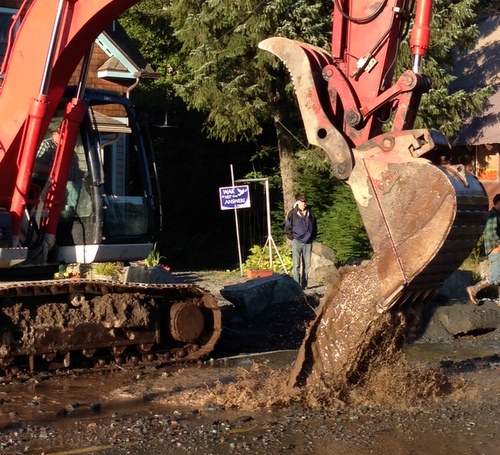
A man watches as heavy equipment works on a water main break in the 700 block of Sawmill Creek Road in October. Repeated repairs like this have “weakened” the city’s Water Fund, according to Finance Director Jay Sweeney. (KCAW photo by Ed Schoenfeld)
Sitkans may be looking at additional increases in water rates in the near future, despite a series of recent hikes to keep the fund afloat.
City finance director Jay Sweeney told the Sitka Assembly in a work session last night that unanticipated expenses had derailed a five-year master plan, and the Water Fund was looking weak.
He also had concerns over the Solid Waste Fund.
Listen to iFriendly audio.
A quarterly financial update is about as mundane as it gets in Sitka’s assembly chambers. But finance director Jay Sweeney was pretty grim talking about the Water Fund. Over the course of the past 17 months, the fund has made a quarter-million dollar stride toward improving its negative balance of working capital — that’s the difference between what needs to be spent on major repairs and improvements and the amount of money on hand. But those repairs just keep on coming.
“We have had several large water main leaks, as the result of aging infrastructure that are not covered by insurance. Especially the one which was near the curve of Sawmill Creek Road, across from Jeff Davis. It was a very expensive leak to fix.”
Sweeney said that one job alone consumed about six month’s worth of the latest rate hike.
And there have been rate hikes, one every year since 2011. This is all according to a Water Fund master plan. But that plan didn’t factor in the installation of an ultra-violet light treatment facility at Blue Lake, which most of the fund’s available cash is designated for.
And the plan didn’t factor in this.
“We now no longer have a viable secondary water source.”
Before the Blue Lake dam was built, Sitka was supplied with water from the Indian River. Although rules regarding surface water have changed, it could still be a fallback — albeit an expensive one.
“Indian River, which was once our secondary water source, requires now some sort of filtration. We know there is a viable alternative in underground water in the Starrigavan Valley, but the challenge is that the water line from the Starrigavan Valley into town, plus the pump stations, are of insufficient size and capability to get that water into town.”
Utility-scale filtration is not cheap. The temporary system Sitka bought to filter Blue Lake water, after the dam is raised and the lake slowly fills up, cost over $3-million.
And Sweeney said that creating a secondary water supply could not be put off indefinitely.
“Somehow we’re going to have to devise a plan because we know — once the hydroelectric facility goes online — within ten years the penstock will need to be shut down yet again for cleaning. That’s our decade-long time to plan and act, and to find an alternative water source, get the funding, and move forward.”
Sweeney said there was a chance the city could “hit a home run” and win grant funding to cover this expense, but he thought it more likely that the assembly would be forced to implement another water rate hike in 2015.
And the bad news didn’t end with the Water Fund. The Solid Waste Fund has typically been in the black, or in the language of high finance…
“In the past, the Solid Waste Fund was always one of our happy funds.”
Sweeney said the fund produced a gross margin, generated cash flow from operations, and increased its working capital. But nine months ago it took a turn for the worse, and has been slipping — by about $19,000 a month.
Sweeney attributed the losses to increases in outside transportation costs, in barging Sitka’s trash to Seattle, and then trucking it to Eastern Washington.
Since these costs are contracted, they can’t really be controlled locally — except for one obvious way.
“If you can reduce your shipping costs. Absolutely, those shipping costs are pound for pound. And big things like food waste and glass would make a huge difference, by increasing that voluntary recycling effort. You’re not going to get any topline revenue from it, but you’re going to help moderate the costs.”
Sweeney said an increase in commodity prices — what Sitka receives for the material it does recycle, like cardboard and plastic — might also help. But he still characterized the recycling program overall as money loser, though not as much of a money loser shipping unsorted garbage.
Without some sort of change, Sweeney anticipated that the assembly would have to consider an increase in the Solid Waste Fund, though not until the next fiscal year.
Happily, Sweeney reported that all other enterprise funds — like Harbors, the Central Garage, and Airport — and the Sitka General Fund, were all healthy.































